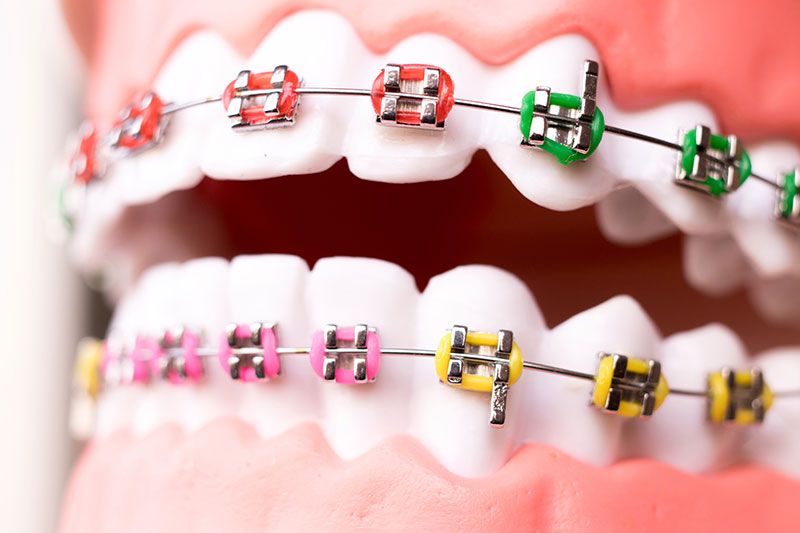
Braces are orthodontic tools that are used on your teeth to fix specific issues like crowding, crooked teeth, or teeth that are out of alignment. Many people get braces when they’re teenagers, but adults can benefit from getting them as well. Braces slowly straighten and align your teeth, so you have a normal bite and symmetrical smile. There are a few different types of braces our orthodontists can place on your teeth.

For most patients, the fun part of orthodontics is being able to select different-colored “O” rings, including mixing and matching the colors for endless combinations. Many patients also have fun selecting colors for their favorite sports teams and holidays. This allows them to express their individuality on their journey to a straighter smile.
For most people, an attractive smile is an important part of the overall impression a person makes and having teeth that are aligned properly can help keep them clean and promote healthy gums. Teeth that are crowded, protruded, or misaligned don’t function ideally, and this can lead to excessive wear and increased sensitivity. And sometimes there are issues with the jaw that should be addressed at a young age. The American Academy of Orthodontics recommends that all children have an appointment with an orthodontist no later than age 7.
The best thing to do if you are unsure if you need braces is to schedule an initial, free consultation with one of our doctors. They can take a look at the alignment of your teeth and help you decide if you can benefit from getting braces.
In general, orthodontics does not hurt. Orthodontic treatment mechanics have advanced technology over the last few years. With the introduction of new high-tech wires, smaller braces, innovative accessories, and stress of preventive/interceptive treatments, it makes today’s orthodontic treatment fairly comfortable. We do not use any anesthetic injections for any of the procedures.
As a rule, braces can cause a little discomfort initially until you get used to them. Also, teeth can get a little sore a day after every adjustment appointment, but they are not painful. This annoyance can be relieved easily with over-the-counter pain relievers, if needed, such as Tylenol or Advil. Most of our patients do not need to take any pain relievers.
Wearing braces does limit the foods that you are permitted to eat. In general, hard, brittle, crunchy and sticky foods should NOT be eaten during treatment. Snacks should be confined to foods without refined sugar and should be followed by brushing or vigorous rinsing if a toothbrush is unavailable. To learn more about food choices, check out our FAQs page on the topic.
When you have braces, you will need to take a little extra care when it comes to keeping your teeth and gums clean and healthy. Brushing will take a little longer, and your diet will need some modifying. There are special toothbrushes and types of floss you can use to clean between wires, braces, and teeth. To get all the details on clea¬ning your teeth while you have braces, check out our FAQs page on the topic.
Most patients with braces continue to play their musical instruments just fine. There may be just an initial period of adjustment. If you experience discomfort when playing your musical instrument, ask your orthodontist about a cover for your braces that can reduce this issue.
Playing sports with braces is fine. It is recommended that patients protect their smiles by wearing a mouth guard when participating in any sporting activity. Mouth guards are inexpensive, comfortable, come in a wide variety of colors and can be purchased at most sporting goods stores.
After your braces come off, then the retention phase is the final step of orthodontic treatment. Removable retainers are worn full-time (except while eating and brushing) in the initial retention phase, then only at night in later months. The purpose of the retention phase is to help stabilize the teeth in their new position and ensure the dazzling new smile will remain for a lifetime, as exact and precise as it was the moment the braces were removed. During the period of night-only wear, we have a chance to evaluate the natural stability of the orthodontic correction and decide if tapering the amount of wear of the retainers is appropriate. For individuals with stubborn teeth that try to return to their pre-treated position and for many adults, routine night wear is the best insurance that their teeth will stay aligned.